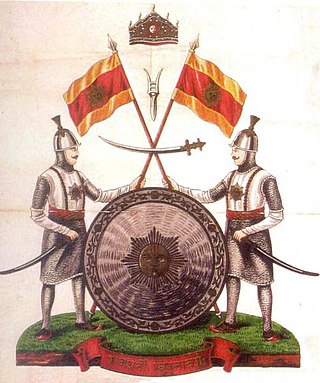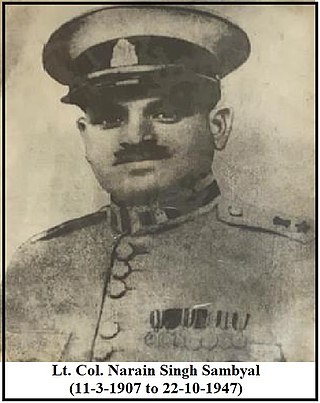The Treaty of Amritsar, executed by the British East India Company and Raja Gulab Singh of Jammu after the First Anglo-Sikh War, established the princely state of Jammu and Kashmir under the suzerainty of the British Indian Empire.

The Gilgit Agency was an agency within the British Indian Empire. It encompassed the subsidiary states situated at the northern border of the princely state of Jammu and Kashmir. The primary objective of establishing the Gilgit Agency was to bolster and fortify these regions, particularly in the context of concerns about Russian encroachment in the area. The subsidiary states encompassed Hunza, Nagar and other states in the present day districts of Gupis-Yasin, Ghizer, Darel, Tangir and Diamer. The agency headquarters was based in the town of Gilgit, which was itself under the direct administration of the Maharaja of Jammu and Kashmir.

Maharaja Sir Hari Singh was the last ruling Maharaja of the princely state of Jammu and Kashmir.

The Jammu and Kashmir Rifles is an infantry regiment of the Indian Army. Its origins lay in the Jammu and Kashmir State Forces of the princely state of Jammu and Kashmir. After the accession of the state to the Indian Union in October 1947, the State Forces came under the command of the Indian Army. They remained in the original form until 1956 when Jammu and Kashmir Constituent Assembly effectively ratified the state's accession to India. Then the State Forces became the Jammu and Kashmir Regiment of the Indian Army. In 1963, the designation was changed to Jammu and Kashmir Rifles. After the conversion, the Ladakh Scouts came under the aegis of the Regiment, where it remained until raised as a separate Regiment in 2002.
The Dogras or Dogra people, are an Indo-Aryan ethno-linguistic group living primarily in the Indian union territory of Jammu and Kashmir and neighbouring Pakistan, consisting of the Dogri language speakers. They live predominantly in the Jammu region of Jammu and Kashmir, and in adjoining areas of Punjab and Himachal Pradesh. Some also live in northeastern Pakistan. Their historical homeland is known as Duggar.

Maharaja Gulab Singh Jamwal (1792–1857) was the founder of Dogra dynasty and the first Maharaja of the princely state of Jammu and Kashmir, which was a part of Panjab and Sikh Empire became the largest princely state under the British Raj, which was created after the defeat of the Sikh Empire in the First Anglo-Sikh War. During the war, Gulab Singh betrayed Sikh Empire for his own greed which helped the British victory, and He was the Prime Minister of Sikh Empire but always wanted to be the Monarch. The Treaty of Amritsar (1846) formalised the transfer of all the lands in Kashmir that were ceded to them by the Sikhs by the Treaty of Lahore.

Ranbir Singh was Maharaja of Jammu and Kashmir from 1856 until his death in 1885.

Sir Pratap Singh was the Maharaja of Jammu and Kashmir, and head of the Jamwal Rajput clan.

The Dogra dynasty of Dogra Rajputs from the Shivalik hills created Jammu and Kashmir when all dynastic kingdoms in India were being absorbed by the East India Company. Events led the Sikh Empire to recognise Jammu as a vassal state in 1820, and later the British added Kashmir to Jammu with the Treaty of Amritsar in 1846. The founder of the dynasty, Gulab Singh, was an influential noble in the court of the Sikh emperor Maharaja Ranjit Singh, while his brother Dhian Singh served as the prime minister of the Sikh Empire. Appointed by Ranjit Singh as the hereditary Raja of the Jammu principality, Gulab Singh established his supremacy over all the hill states surrounding the Kashmir Valley. After the First Anglo-Sikh War in 1846, under the terms of the Treaty of Lahore, 1846, the British Indian government acquired Kashmir from the Sikh Empire and transferred it to Gulab Singh, recognising him as an independent maharaja. Thus, Jammu and Kashmir was established as one of the largest princely states in British India, receiving a 21-gun salute for its Maharaja in 1921. It was ruled by Gulab Singh and his descendants till 1947.

Poonch District was a district of the princely state of Jammu and Kashmir, which is currently divided between India and Pakistan. The Pakistani part of the erstwhile district is now the Poonch Division in the Azad Kashmir territory, whilst the Indian part of the district is the Poonch district in Jammu and Kashmir. The capital of the Pakistan-controlled side is Rawalakot; while the capital of the Indian-controlled side is Poonch.

Government Sri Ranbir Model Higher Secondary School named after its founder Maharaja Ranbir Singh, is commonly known as SRML School and Ranbir School, It is a government boys higher secondary school in Jammu district of Indian union territory of Jammu and Kashmir. It is the first high school of Jammu region which was established by Maharaja Ranbir Singh in the late 19th century to promote higher school education in the state, then called as Rabir pathshala. The school is presently affiliated to Jammu and Kashmir Board of School Education (JKBOSE).
Mankotia is an Indian surname belonging to a Rajput clan. The clan predominantly resides in the Indian states of Himachal Pradesh and Jammu and Kashmir. The name originates from the town Mankot, now Ramkot, Jammu and Kashmir.
The Rakwal is a Rajput clan found mainly in the Indian states of Himachal Pradesh and Jammu and Kashmir, districts of Punjab like pathankot. Their immediate ancestor was King Raja Abta Deo of Jammu, who founded a principality in Sialkot. They are a Dogra sub-group, and their customs are similar to other Dogras Rajputs. Rakwal Rajputs are Suryavanshi Linage Rajputs of Jammu and Kashmir. The rakwal Rajputs intermarry with the Sulehria, Langeh, Andotra, Bhalwal, Baghal, lalotra, Manhas, Rana, Parihar, Jamwal, Rathore, Sambyal, Charak and Jaj.

Jammu is a city in Indian-administered Jammu and Kashmir in the disputed Kashmir region. It is the winter capital of Jammu and Kashmir, which is an Indian-administered union territory. It is the headquarters and the largest city in Jammu district. Lying on the banks of the river Tawi, the city of Jammu, with an area of 240 km2 (93 sq mi), is surrounded by the Himalayas in the north and the northern plains in the south. Jammu is the second-most populous city of the union territory. Jammu is known as "City of Temples" for its ancient temples and Hindu shrines.

Brigadier Rajinder Singh Jamwal, MVC, also remembered as the Saviour of Kashmir, was an officer in the Jammu and Kashmir State Forces. He briefly served as the Chief of Staff of State Forces and died fighting during the First Kashmir War. Rajinder Singh and his small contingent of about 200 men successfully delayed the advance of a much larger force of Pakistani tribal raiders near Uri for several days, during which the Maharaja of Kashmir acceded to India and the Indian forces air-lifted for the defence of Kashmir.

Colonel Narain Singh Sambyal, OBE, also remembered as the Savior of Kashmir, was a Commander of 4th Jammu and Kashmir State Forces who died fighting during the First Kashmir War at Domel Muzaffarabad.
Mian Dido Jamwal (1780-1821) was a Dogra Rajput warrior from the Jamwal clan who rebelled against the overlords of Jammu during the Sikh Empire of Maharaja Ranjit Singh. He was descended from Raja Hari Dev of Jammu. Mian Dido was extremely popular among the common people of Jammu, and even today he is the subject of several ballads and legends. He is considered a hero and propagator of the regional identity of Jammu in political terms. He was killed by the troops of Gulab Singh after being surrounded.












